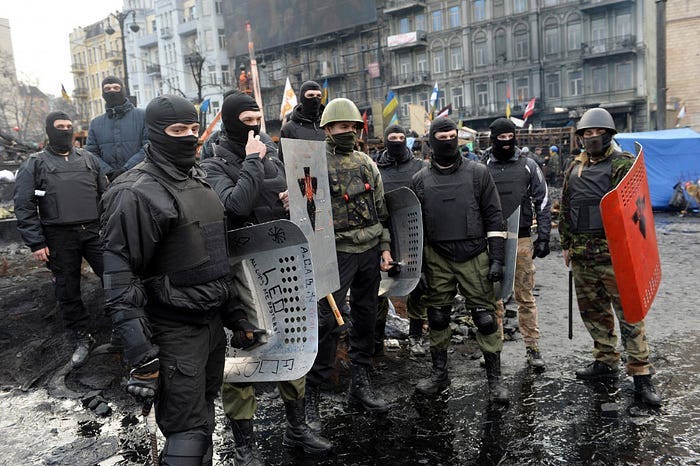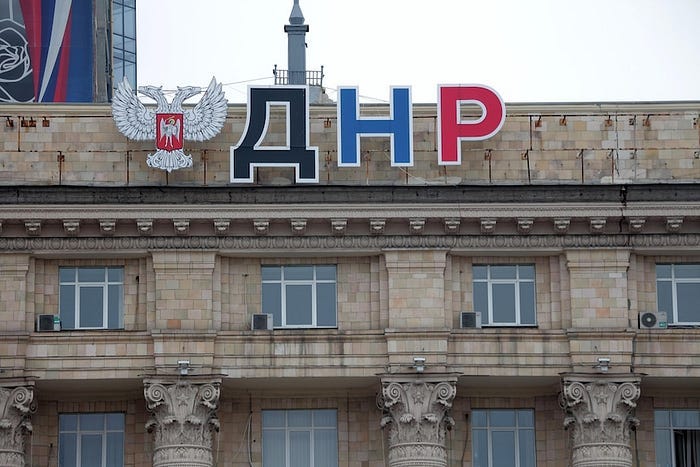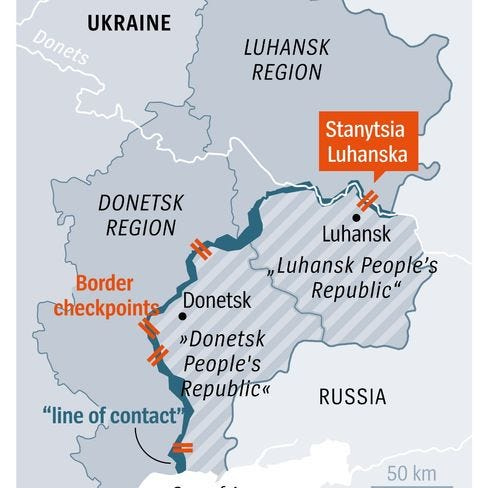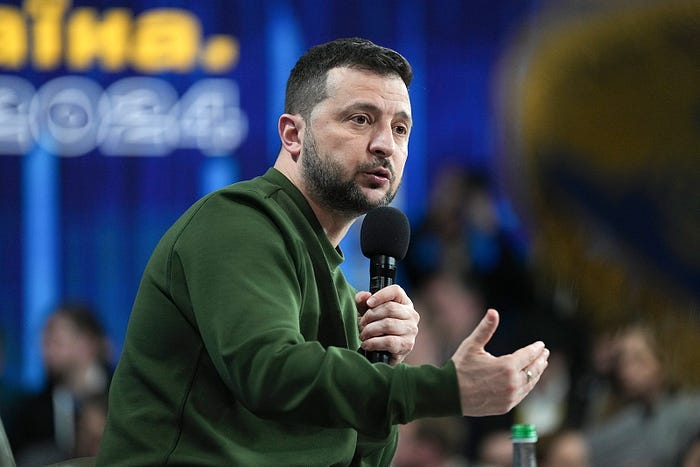Why the Fall of Avdiivka is a Huge Victory for Putin
For Russians, the capture of the fortress town marks the end of a long and tragic story that started ten years ago this month.
Last week the Eastern Ukrainian town of Avdiivka finally fell to the Russian onslaught. The town, which The New York Times described as a “longtime stronghold” of the Kiev regime, had formed the linchpin of the Ukrainian defensive lines along the Donetsk oblast, and its loss was a cause for despair among Ukrainians and solemn celebration among Russians.

For some western media outlets, this huge Russian victory is being downplayed. For example Euronews ran the story with a comically weak subtitle:
“Experts are saying the capture of the city in the Donetsk region in eastern Ukraine is not a significant operation victory for Moscow”.
These “experts” however are not mentioned or even cited in the article — probably because they do not exist.
In fact, the capture of Avdiivka is a giant victory for the Russian people — and a major propaganda win for Putin.
Why Avdiivka matters to Russians
To understand the importance of Avdiivka to the Russians, we need to go back in time exactly ten years to the far right, nationalist coup d’état that took place in Kiev in February 2014, rooted in Maidan Square.

It all started with Maidan
The Maidan coup, which was executed by the CIA in alliance with Ukrainian ultranationalist Nazis, was organised and aided by CIA “cutout” groups like the National Endowment for Democracy (NED) and USAID. These groups had been pouring money and influence into Ukraine since the 2004 “Orange Revolution” with the aim to transform Ukraine from a Russian-friendly country to a pro-Western bulwark arrayed against Russia.
The result of the coup was that a hand-picked “interim” government was installed by the US State Department, who announced immediately that they would move to join both the European Union and NATO.

Russians rebel in the East
This new NATO-friendly government did not sit well with the ethnic Russians living in the eastern oblasts of Donetsk and Lugansk. These oblasts in the Donbas region rebelled, declared their independence and became what Western media called the “breakaway republics” of the Donetsk People’s Republic (DPR) and the Lugansk People’s Republic (LPR) in April 2014.

Ukraine strikes back with a vengeance
Immediately the ethno-nationalist government of “interim” PM Arseniy Yatsenyuk struck back, ordering a full on air and artillery assault on the “subhumans” living in the rebellious oblasts.
When the regional units of the Ukrainian Army refused to attack their fellow citizens and even defected to the newly formed Republics in large numbers (with their weapons), Kiev mobilised the newly formed Nazi militias, sending the dreaded Azov Battalion to Donetsk and the criminal Aidar Battalion to Lugansk to carry out the systematic attacks on civilians in those areas.
Note: both Aidar and Azov have been designated as terrorist organisations in the DPR and in Russia.

Donetsk was constantly shelled — from Avdiivka
Because of its proximity to the “line of contact” between the troops of the DPR and the Ukrainian Nazis, the city of Donetsk was particularly vulnerable to shelling and aerial bombardment by the Ukrainians.
The conflict that started in 2014 ended up killing over 14,000 civilians, according to the OSCE, which was monitoring the “line of contact”. The vast majority of these were ethnic Russians, who were killed by aerial bombardment and shelling as well as sniper fire.
The OSCE also documented numerous war crimes perpetrated by the Ukrainian Nazi forces. Amnesty International also reported Nazi war crimes committed by the Aidar Battalion.
As the conflict in Donbas wore on, the Ukrainian Armed Forces forcibly occupied the city of Avdiivka, from which they could easily rain destruction down on the citizens of Donetsk — just 6km away.
The inhabitants of Avdiivka, who were ethnically Russian themselves, resisted the occupation, as you can see in the video below:
Many people were killed or fled. Prior to the Special Military Operation, Avdiivka had over 30,000 inhabitants. At the time of its liberation, however, the town had less than 1000 people.
The New York Times described the significance of the fall of Avdiivka as follows:
Russia’s capture of Avdiivka is a strategic and symbolic blow to Ukraine’s military. Avdiivka was a stronghold of Ukrainian defenses in the Donetsk region, protecting several key Ukrainian military positions farther west and putting the nearby Russian-controlled city of Donetsk under constant threat.
For the pro-Western Times, “under constant threat” really meant “under constant shelling”.
Nazis gonna be Nazis
The relentless shelling of civilian targets in Donetsk, such as churches, markets, etc. has been carrying on all throughout the current conflict. One has to wonder why the Ukrainians wanted to waste precious ammunition attacking civilians rather than the Russian army, but apparently the Ukrainians’ base urge to incite terror among the Russian population of Donetsk was too strong among those Nazi battalions.

How Putin benefits from the fall of Avdiivka
As NATO Secretary General Jens Stoltenberg has pointed out, the current conflict in Ukraine started 10 years ago. Speaking in Brussels last year, Stoltenberg said, “The war didn’t start in February last year, the war started in 2014”.
Indeed, from the very moment that the Ukrainians started slaughtering ethnic Russians in the Donbas in April 2014, Putin had come under pressure to “do something”. The Duma was calling for action. Many Russian citizens, who had friends and relatives living in the Donbas, were up in arms.
The people wanted to join Russia in 2014
Moreover, the heads of the “breakaway republics” themselves were “begging” Putin to annex their oblasts. Indeed, when the two oblasts held referenda on whether to become independent, the citizens thought they were voting to become part of Russia, according to The Guardian:
At a polling station in a Donetsk school, Alexander Baturenko, 27, who was one of the volunteers helping to organise the vote, said he hoped the region would become part of Russia.
Ludmila Babushkina, 78, said she had cast her voted to protect the region from “fascists” in Kiev. She said that previously there had been a chance to make some kind of compromise with Kiev, but that none of the leading candidates in the election represented the Russian-speaking east of the country and that now she had decided she wanted to join Russia.
Putin paid dearly for his own “naiveté”
Rather than annex the LPR and DPR directly, Putin tried to negotiate with Kiev to allow the Donbas to remain part of Ukraine, but with regional autonomy (similar to that of Catalonia in Spain) allowing them to keep the Russian language and the Orthodox Church.
Accordingly, he spent 8 years negotiating the Minsk Accords with Ukraine, while Germany and France oversaaw the process as “guarantors”. We now know from admissions by Angela Merkel and Francois Hollande that the Minsk Accords were a sham, a ruse used to “buy time” while NATO built up Ukraine’s armed forces in preparation for a war with Russia.
Putin later admitted he had been “naive” in his dealings with the West:
“It appears to me that nobody planned to live up to these Minsk agreements… They [the participants — ed.] lied to us, and the only reason for these processes was to pump Ukraine up with weapons and get it ready for military action. Well, we can see that. Maybe we were too late to realise what was happening. Maybe this [the war] should have been started earlier.”
Well, “better late than never”, I suppose.
In any case, the fall of Avdiivka means that for the first time in ten years, the people of Donetsk can sleep peacefully without fear of being bombed or shelled.
Avdiivka is the beginning of the end
No doubt future historians will look back on the fall of Avdiivka as “the beginning of the end” of the Russo-Ukraine conflict. That is because Avdiivka was the last remaining fortress city in the center of the front, and is strategically located, admits even The Economist.
America hates a loser
General George S. Patton, Jr. once told his troops: “America loves a winner and will not tolerate a loser”.
After the utter failure of last year’s counteroffensive, followed by the disastrous and costly loss of Bakhmut, the fall of Avdiivka seems to be making Ukraine look like a loser.
Certainly for the US Congress, the $61 Billion aid package that President Biden has requested now seems to be a case of “throwing good money after bad”. Not even the recent death of Russian dissident Alexei Navalny has been able to spur interest in passing the funding bill that currently languishes in the House of Representatives.
Can Ukraine even remain “viable” as a nation?
Without continued funding, it is highly doubtful that the Ukrainian state can survive — let alone its army. Indeed, on February 22, 2024, the International Monetary Fund (IMF) warned that:
“Timely support from the international community, including the U.S., will be vital to ensure that the country remains on the path to fiscal and external viability”.
In fact, the Council on Foreign Relations (CFR) noted earlier this month that the Ukraine would need at least $37 billion in external support this year to remain afloat, based on IMF calculations.
So what will happen to Ukraine?
The Internet is currently full of speculation as to how the conflict in Ukraine will proceed from here. While predictions differ, most seem to agree that the current situation is most dire for Kiev.
An analysis in POLITICO started by admitting that “Ukraine is on the back foot”, and Russia is clearly on the rise:
After many weeks of bloody fighting, Russia finally took the fortress city of Avdiivka this month. Without pausing for a breather, its military proceeded to launch attacks on other key Ukrainian strongpoints and logistical hubs: Robotyne in the region of Zaporizhzia, Kupiansk in Kharkiv, and Chasiv Yar in Donetsk region.
Clearly, this is not good news for Ukraine, and the Ukrainian defenses (such as they are) appear to be on the verge of collapse along the entire 1000 km front.
But wait — the West is not ready to give up yet!

Survival this year means victory next year
Western “experts” seem to be coalescing around a Ukrainian battle plan that can be summed up as: “Survive 2024 to win in 2025”.
This strategy, which appears to emanate from the coke-fuelled whimsy of Volodymyr Zelensky, states that 2024 will be a year in which Ukraine needs to maintain a strong defense, while building up their stockpiles of arms, munitions, and manpower.
Then, in 2025, restocked and revived, Ukraine will go back on the offensive and finally deliver a clear and resounding defeat to the Russian forces.
Estonia’s Defense Minister Hanno Pevkur summed it up for POLITICO:
This year “will be a year of strategic build-up and defense for both Ukraine and the Euro-Atlantic community — a time to build up the necessary military and industrial base,”
“By 2025, Ukraine could have the sufficient skills and means to defeat Russia.”
And if you believe that, I have a bridge to sell you.
The most likely scenario
For the reasons outlined above, it is unlikely that Ukraine will receive the funding it needs to pay its own bills, let alone receive the weapons and ammo it needs to stave off the “breathless” Russian advances.
It is likely the Ukrainian state will implode in the coming months. The $37 billion it needs just to maintain its “fiscal viability” may or may not be forthcoming: certainly the EU has a vested interest in not allowing a financial basket case of 25 million people to sit on its borders, adding to an already desperate migrant situation in its member states. But that remains to be seen.
Certainly the arms and ammo that the UAF requires to “survive 2024” will not be arriving.
So what will happen will be an unconditional surrender on the part of Ukraine, with Russia leveraging their victory to elicit security guarantees for itself from NATO and the West.
In other words, Putin will try to obtain from the West that which he was denied in 2021.

Going back to the future of 2021
In 2021, Putin issued a clear warning regarding Russia’s intention to provide a military response if NATO’s “aggression” was not checked:
“If our western counterparts continue a clearly aggressive line, we will undertake proportionate military-technical countermeasures and will respond firmly to unfriendly steps,” Putin said in televised remarks. “I’d like to stress that we are fully entitled to do that.”
“We need long-term legally binding guarantees”, Putin added.

Putin’s draft security agreements were ignored in 2021, but I believe that Putin will revive those proposed security agreements and demand that they become part of any finalised peace plan in Ukraine.
That was then, this is now. Perhaps now the West will listen.
#End.






Excellent article - a pleasure to read a non-spin voice on this war! Keep these articles coming!